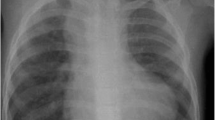Abstract
Cyanosis is always pathological and demands detailed evaluation. Combined use of clinical findings, electrocardiogram and chest radiograph permits determination of underlying cause in vast majority. Stepwise approach allows hemodynamic classification of the cardiac lesion and directs immediate management. Accurate anatomic diagnosis of the cardiac malformation is seldom essential for preliminary management and therefore, emphasis must be on clinical classification rather than on obtaining echocardiographic diagnosis.





Similar content being viewed by others
References
Lundsgaard C. Studies on cyanosis. I and II. J Exp Med. 1919;30:259–93.
Lundsgaard C, Van Slyke DD. Cyanosis. Medicine. 1923;2:1–76.
Lees MH. Cyanosis of the newborn infant. Recognition and clinical evaluation. J Pediatr. 1970;77:484–98.
Jennis MS, Peabody JL. Pulse oximetry: an alternative method for the assessment of oxygenation in newborn infants. Pediatrics. 1987;79:524–8.
Ewer AK, Middletonn LJ, Furmston AT, et al; PulseOx study group. Pulse oximetry screening for congenital heart defects in newborn infants (PulseOx): a test accuracy study. Lancet. 2011;378:785–94.
Ewer AK. Pulse oximetry screening for critical congenital heart defects in newbron infants: should it be routine? Arch Dis Child Fetal Neonatal Ed. 2014;99:F93–5.
Koppel RI, Druschel CM, Carter T, et al. Effectiveness of pulse oximetry screening for congenital heart disease in asymptomatic newborns. Pediatrics. 2003;111:451–5.
Thangaratinam S, Brown K, Zamora J, Khan KS, Ewer AK. Pulse oximetry screening for critical congenital heart defects in asymptomatic newborn babies: a systemic review and meta-analysis. Lancet. 2012;379:2459–64.
Sasidharan P. An approach to diagnosis and management of cyanosis and tachypnea in term infants. Pediatr Clin North Am. 2004;51:999–1021.
Tingelstad J. Nonrespiratory cyanosis. Pediatr Rev. 1999;20:350–2.
Kopelman AE, Mathew OP. Common respiratory disorders of the newborn. Pediatr Rev. 1995;16:209–17.
Fuloria M, Kreiter S. The newborn examination. Part I. Am Fam Physician. 2002;65:61–8.
Schwartz R, Teramo KA. Effects of diabetic pregnancy on the fetus and newborn. Semin Perinatol. 2000;24:120–35.
Kjos SL, Walther FJ, Montoro M, Paul RH, Diaz F, Stabler M. Prevalence and etiology of respiratory distress in infants of diabetic mothers: predictive value of fetal lung maturation tests. Am J Obstet Gynecol. 1990;163:898–903.
Hook B, Kiwi R, Amini SB, Fanaroff A, Hack M. Neonatal morbidity after elective repeat cesarian section and trial of labor. Pediatrics. 1997;100:348–53.
Levine EM, Ghai V, Barton J, Strom CM. Mode of delivery and risk of respiratory diseases in newborns. Obstet Gynecol. 2001;97:439–42.
Rusakow LS, Khare S. Radiographically occult congenital lobar emphysema presenting as unexplained neonatal tachypnea. Pediatr Pulmonol. 2001;32:246–9.
Nadroo AM, Levshina R, Tugertimur A, Gudavalli M, Raziuddin K. Congenital diaphragmatic hernia: atypical presentation. J Perinat Med. 1999;27:276–8.
Grifka RG. Cyanotic congenital heart disease with increased pulmonary blood flow. Pediatr Clin North Am. 1999;46:405–25.
Marino BS, Bird GL, Wernovsky G. Diagnosis and management of the newborn with suspected congenital heart disease. Clin Perinatol. 2001;28:91–136.
Wren C, Reinhardt Z, Khawaja K. Twenty-year trends in diagnosis of life- threatening neonatal cardiovascular malformations. Arch Dis Child Fetal Neonatal. 2008;93:F33–5.
Cloherty JP, Eichenwald EC, Stark AR. Manual of neonatal care. 6th ed, South Asian edition, 4th Indian reprint edition. New Delhi: Wolters Kluwer Company; 2009.
Cleveland RH. A radiologic update on medical diseases of the newborn chest. Pediatr Radiol. 1995;25:631–7.
Tandon R. Bedside approach. In: Tandon R, editor. The diagnosis of congenital heart disease. 2nd ed. New Delhi: Sitaram Bhartia Institute of Science and Research Publishers; 2011.
Allen HD, Driscoll DJ, Shaddy RE, Timothy FF. Moss and Adam’s Heart disease in infants, children and adolescents: including the fetus and young adults. 8th ed. Philadelphia: Lippincott Willaims and Wilkins; 2012.
Acknowledgments
The author is grateful to Dr. Sandeep Singh, Professor of Cardiology, All India Institute Medical Sciences, New Delhi for critical review of the manuscript.
Contributions
SKG prepared and finalised the manuscript. Anita Saxena, Professor of Cardiology, Department of Cardiology, AIIMS, New Delhi, India, will act as guarantor for this paper.
Conflict of Interest
None.
Source of Funding
None.
Author information
Authors and Affiliations
Corresponding author
Rights and permissions
About this article
Cite this article
Gupta, S.K. Clinical Approach to a Neonate with Cyanosis. Indian J Pediatr 82, 1050–1060 (2015). https://doi.org/10.1007/s12098-015-1871-7
Received:
Accepted:
Published:
Issue Date:
DOI: https://doi.org/10.1007/s12098-015-1871-7




